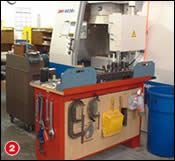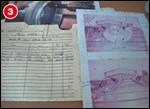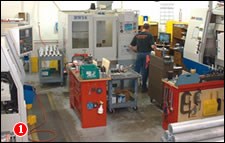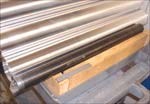Lean From The Get-Go
This shop was lean from day one. Its visual management tools form its lean manufacturing foundation.
Culture shock is one of the biggest obstacles to implementing lean manufacturing into an existing shop. Getting experienced shop workers to adopt a lean waste-ridding mindset often isn't the easiest thing to do. R&D Manufacturing Industries, Inc., located in Ocala, Florida, didn't have to jump that hurdle because it was lean right out of the blocks.
The combined work experience of the shop's principals melds into an interesting blend of business acumen and machine shop experience. Ron Malone, company president, has amassed a wealth of lean manufacturing knowledge during 10 years in the automotive supply industry. He's also an engineer and attorney. His partner, Dennis Miller, is a 30-plus-year tool and die veteran.
How the two first met is also interesting. Before joining forces in January 2004, they competed together at Shriners of North America motorcycle events on their Harley Davidson motorcycles. (Machine tools are neat, but the two gleaming white "Hogs" parked at the shop were what first caught my eye during my visit.)
When founding the shop, the partners' business plan was to apply only those lean tools appropriate for their situation, not haphazardly shotgunning lean techniques that may or may not prove fruitful in eliminating waste in a contract shop. Mr. Malone knew that visualization, which is essential for the success of any lean manufacturing program, would play a key role in the set up of the new shop. "An employee should be able to walk through a work area one time and come away with 90 percent of the information about that area after that first tour," Mr. Malone explains. Not only does this streamline experienced workers' day-to-day duties and improve their productivity, but it also helps new hires to ramp up quickly. Visual management tools, including 5S organization, allow such quick information access.
It's common knowledge what a picture is worth. The following pictures illustrate a few of the ways that visualization was incorporated in this lean shop from day one.
1. Visualize Shop Layout—To control up-front costs, R&D chose a modest 3,000-square-foot building that offered additional space as the company grew. The compact floor space was a blank slate, and the two partners spent a great deal of time designing a layout of equipment that would promote economy of motion and unrestrictive flow of parts and persons.
The shop's first two CNC machines were a Puma 240 lathe from Daewoo (West Caldwell, New Jersey) and a RW14 VMC from Milltronics (Waconia, Minnesota) that were positioned closely together in an L-shaped cell. About a year later, a Daewoo DMV 4020 VMC was added to form the current U-shaped cell. Close machine proximity minimizes worker motion to allow tending of multiple machines. Typically two workers, but sometimes only one, will tend the entire cell. A second CNC lathe, the shop's and possibly South Florida's largest, was purchased with the prospect of winning a tough turning job (see sidebar). Though this Daewoo Puma 300L machine is dedicated to large-part production, and is not part of the three-machine cell, its position near the cell allows it to be operated by the U-cell associates.
Worktable size was also kept to a minimum, as large horizontal spaces tend to attract unnecessary clutter to a work area. Even the shop's material rack is small, because the company orders material very close to the time that a machining job will start so as not to have money and space tied up before the material is needed. R&D maintains a close relationship with its material suppliers and other vendors to ensure that they will do whatever it takes to deliver services on time.
Work areas that are compact, but not cramped, not only promote efficient motion, but also improve scheduling accuracy by allowing a more precisely predictable determination of a job's total cycle time. This total cycle time is not just the time a machine is producing chips; it takes into account all factors involved in part production, such as setups, inspection, secondary operations and so on. This is especially important when maintaining a supermarket of parts for a customer. As Mr. Malone explains, the prime reason that supermarkets fail are because the supermarket is sized incorrectly. The trick to formulating the appropriate supermarket size is to know the shop's total cycle time and customer's takt time (based on the number of parts that the customer is pulling on a regular basis).
2. 5S Organization—This idea of a more predictable motion is also a function of 5S organizational principles, which are direct extensions of the visual factory theme and staples of any lean push. Just what the 5S's stand for can differ from shop to shop (they typically represent sort, shine, simplify, standardize and sustain). For R&D, the 5S concept means having tools where they're needed when they're needed. A couple of examples are having a tape measure sitting by the saw rack, instead of in a toolbox, or using a magnet to hold a straight edge on a machine tool's enclosure, rather than sitting on a worktable. In order to minimize wasted motion, R&D will sometimes purchase extra hand tools and spread them out in key areas of the shop.
Shadow boards, tool chest labeling and fixture identification are other examples of how it applies 5S to its shop. From day one, each new employee is told to put things back where they belong. The conversation probably goes something like, ‘there's the hook, here's the wrench, hang it there every time.'
3. Setup Photos—Each time a new job is set up, R&D takes photos of the fixtures, tools—anything that will be helpful in setting up the job again so there is no wheel-reinvention the next time that job comes through the shop. These photos, along with standardized work sheets, are included in each manila job folder.
This paper-based system allows workers to quickly write down measurements or jot down notes directly on job sheets or setup photo printouts. Paperless systems have their merits, especially in terms of controlling documents and procedures, but Mr. Malone's desire for a visual factory overrides his desire for paperless documentation. "I can pick up a folder, for example, and look at a number of papers at once to get all the information about a job at an instant," Mr. Malone explains. "This is much quicker than navigating through a computer and viewing a variety of documents separately—that's if the computer isn't already being used by another worker."
4. On-Deck Boards—Each machine tool has a simple dry-erase board that lists the number of the current job running on the machine as well as prioritized jobs in queue. The beauty of these boards is that with a quick scan, operators know the job sequence, so they can start collecting tools, doing necessary programming or completing any other duties to prepare for setting up that next job. This not only makes for effective use of what would otherwise be worker downtime, but also assists in job scheduling. The owners can easily change job sequence if, for example, a customer needs parts sooner than expected.
Focus On Herbie
Continuous improvement (kaizen in lean lingo) is a core concept that every manufacturer hoping to remain competitive must employ. That said, the choice of which process to improve is equally important. There's no point boosting a race car's horsepower, for example, if its transmission is slipping. Similarly, there's no point in adding a lightning-fast machine to a work cell if it is going to result in excessive work in process (WIP).
Enter "Herbie," who is illustrative of a continuous improvement approach that targets the slowest, most constrictive process. Herbie is a character in "The Goal," a production management book written by Eliyahu Goldratt. As the story goes, Herbie is part of Boy Scout troop who, on a single-file hike, becomes the constraint that hinders the troop's progress because the Scouts are not allowed to pass the slowest member (Herbie).
In terms of a machine shop, Herbie is the prime production bottleneck. R&D meets at least twice a week to identify Herbie. According to Mr. Malone, once Herbie is found, the trick is to make him the shop's heartbeat so that all the other processes work in conjunction with that pace. "The key is to have all processes flowing work at that same rate," says Mr. Malone. "Otherwise, WIP will increase, and that WIP could waste valuable floor space or potentially turn to scrap."
Once the bottleneck is fixed, Herbie goes somewhere else in the manufacturing process and must be found again. In such cases, a more costly special tool or vise may be appropriate if it solves the prime bottleneck. Milling capability was R&D's most recent Herbie. Though its first VMC remained capable of performing its machining duties, it became overworked and couldn't keep up with the speed at which the CNC lathes fed it work. This bottleneck opened with the addition of a second VMC.
Walk Through
Each work day at R&D ends with the partners taking a quick walk through the shop, looking at the on-deck boards and/or job folders to get a sense of whether or not scheduling changes are necessary. Then the following morning, the two meet with all workers to discuss any "hot" jobs, which can change daily. The visual tools are one way that the shop can change gears quickly to keep up with changing customer needs.
Mr. Malone sums up the visual factory concept in this way: "If everything is identified and shop work space is just large enough to hold what you need—and only what you need—then you eliminate the ability to create waste."
Related Content
When Handing Down the Family Machine Shop is as Complex as a Swiss-Turned Part
The transition into Swiss-type machining at Deking Screw Products required more than just a shift in production operations. It required a new mindset and a new way of running the family-owned business. Hardest of all, it required that one generation let go, and allow a new one to step in.
Read MoreFinally, A Comprehensive Software Solution Designed for Small Job Shops
Zel X from Siemens is an integrated software application that consolidates collaboration, design, manufacturing, and operations into a comprehensive, easy-to-use solution. From RFQ to delivery, it’s a more efficient way to handle quotes, manage jobs, make parts, and collaborate with teams of all sizes.
Read MoreCan Connecting ERP to Machine Tool Monitoring Address the Workforce Challenge?
It can if RFID tags are added. Here is how this startup sees a local Internet of Things aiding CNC machine shops.
Read MoreSolve Worker Shortages With ACE Workforce Development
The America’s Cutting Edge (ACE) program is addressing the current shortage in trained and available workers by offering no-cost online and in-person training opportunities in CNC machining and metrology.
Read MoreRead Next
The Cut Scene: The Finer Details of Large-Format Machining
Small details and features can have an outsized impact on large parts, such as Barbco’s collapsible utility drill head.
Read More3 Mistakes That Cause CNC Programs to Fail
Despite enhancements to manufacturing technology, there are still issues today that can cause programs to fail. These failures can cause lost time, scrapped parts, damaged machines and even injured operators.
Read More
.jpg;width=70;height=70;mode=crop)




























.png;maxWidth=300;quality=90)







